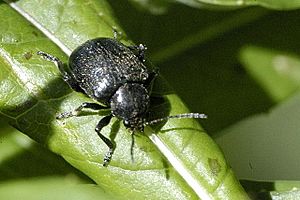Western grape rootworm facts for kids
Quick facts for kids Western grape rootworm |
|
|---|---|
 |
|
| Scientific classification | |
| Synonyms | |
|
The Bromius obscurus is a type of leaf beetle. It's also known as the western grape rootworm. This beetle is the only species in its group, called a genus. You can find it in many parts of the world. It lives in North America, most of Europe, and Asia. Sadly, it's known to be a pest for grape vines in Europe and western North America.
Scientists have found fossils of B. obscurus in northeastern Russia. These fossils show that the beetle lived there a very long time ago, during the late Pleistocene era.
Contents
Naming the Beetle
The Bromius obscurus beetle was first described by a famous scientist named Carl Linnaeus. He gave it the name Chrysomela obscura in 1758. This was in his important book, the 10th edition of Systema Naturae.
Later, in 1836, another scientist named Louis Alexandre Auguste Chevrolat created the group (genus) called Bromius. He included Linnaeus's beetle in this new group. Over time, scientists agreed that Bromius was the correct name for this beetle's group.
What Does it Look Like?
Adult Bromius obscurus beetles are usually black. They are covered with dull yellow-grey hairs, which makes them look a bit fuzzy. Their wing covers (called elytra) and lower legs (tibiae) can be either black or a reddish-brown color. The first four parts of their antennae are usually orange-red.
Scientists have noticed a few different looks for this beetle:
- Typical form: These beetles have black wing covers with whitish hairs.
- var. weisei (named by Lucas Friedrich Julius Dominikus von Heyden in 1883): These have black wing covers with yellowish hairs. Their lower legs are reddish-brown at the base.
- var. epilobii (named by Julius Weise in 1882): These beetles have brown wing covers and lower legs, with whitish hairs.
- var. villosulus (named by Franz von Paula Schrank in 1781): These have brown wing covers with yellowish hairs.
Sometimes, scientists used to wonder if the obscurus and villosulus types were different species. Now, most think they are just different forms or subspecies of the same beetle.
Where it Lives
The B. obscurus beetle is found across a very large area called the Holarctic region. This means it lives in both the northern parts of the world.
In North America, you can find it all over Canada. It also lives south into North Carolina in the east and California in the west. In Asia, it's one of the few types of its beetle family found in northern Siberia.
In the United Kingdom, this beetle was once known from only one small area. This was near the border of Cheshire and Staffordshire. However, it hasn't been seen there since 1992. More recently, in 2014, it was found in one spot in Scotland. This is now the only known place it lives in the UK.
How it Reproduces and Other Cool Facts
B. obscurus beetles have a unique way of reproducing. In North America, they reproduce sexually, meaning both male and female beetles are needed. But in Europe, the populations reproduce asexually. This means the females can lay eggs that hatch without a male beetle. This is called parthenogenesis.
Scientists have also found a special sound-making part on the wings of B. obscurus. It's a small, dark, raised spot near the end of each wing. This is the first time such a part has been seen in this group of beetles.
These beetles also have helpful Symbiotic bacteria living inside their gut. These bacteria help the beetle in some way. In female beetles, these bacteria are also found in special organs related to reproduction. Scientists have studied these bacteria and found they belong to a specific group called Gammaproteobacteria.

